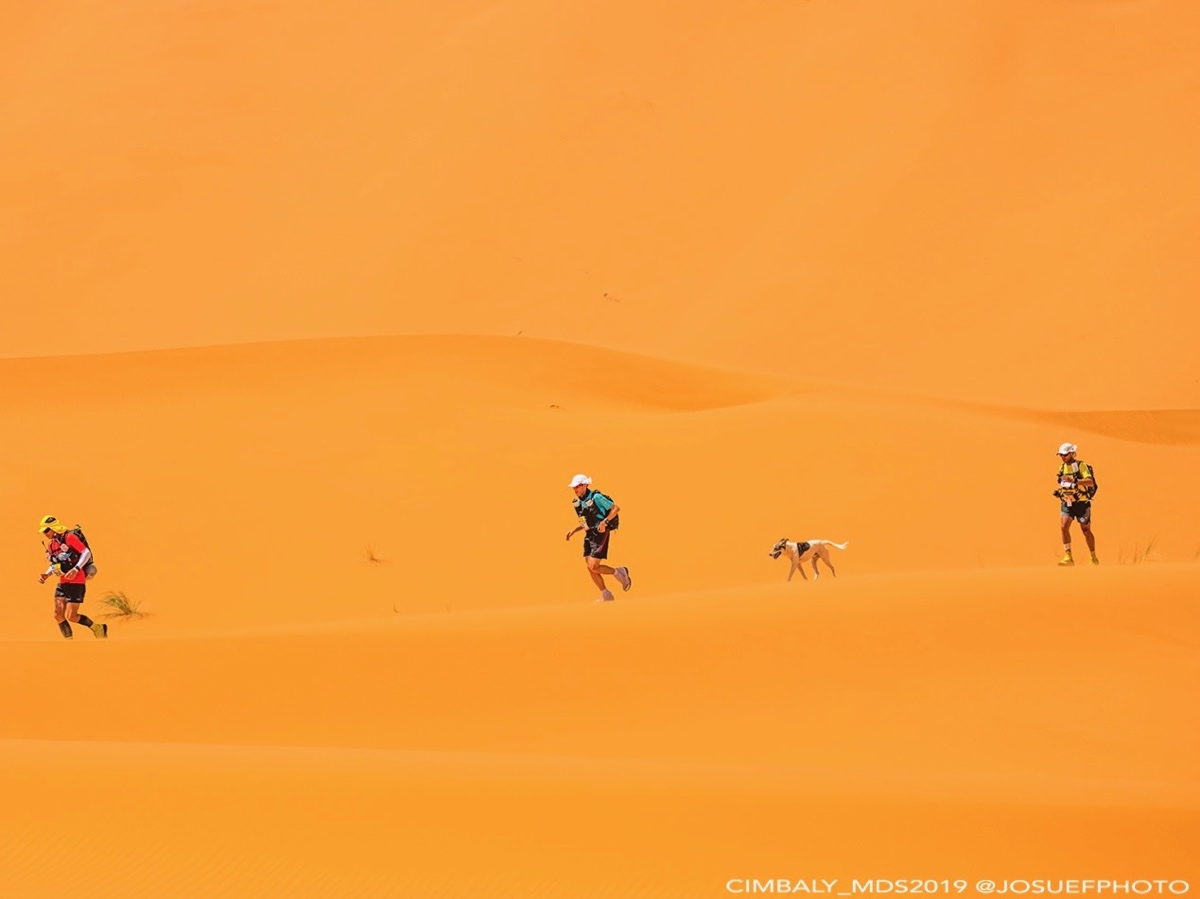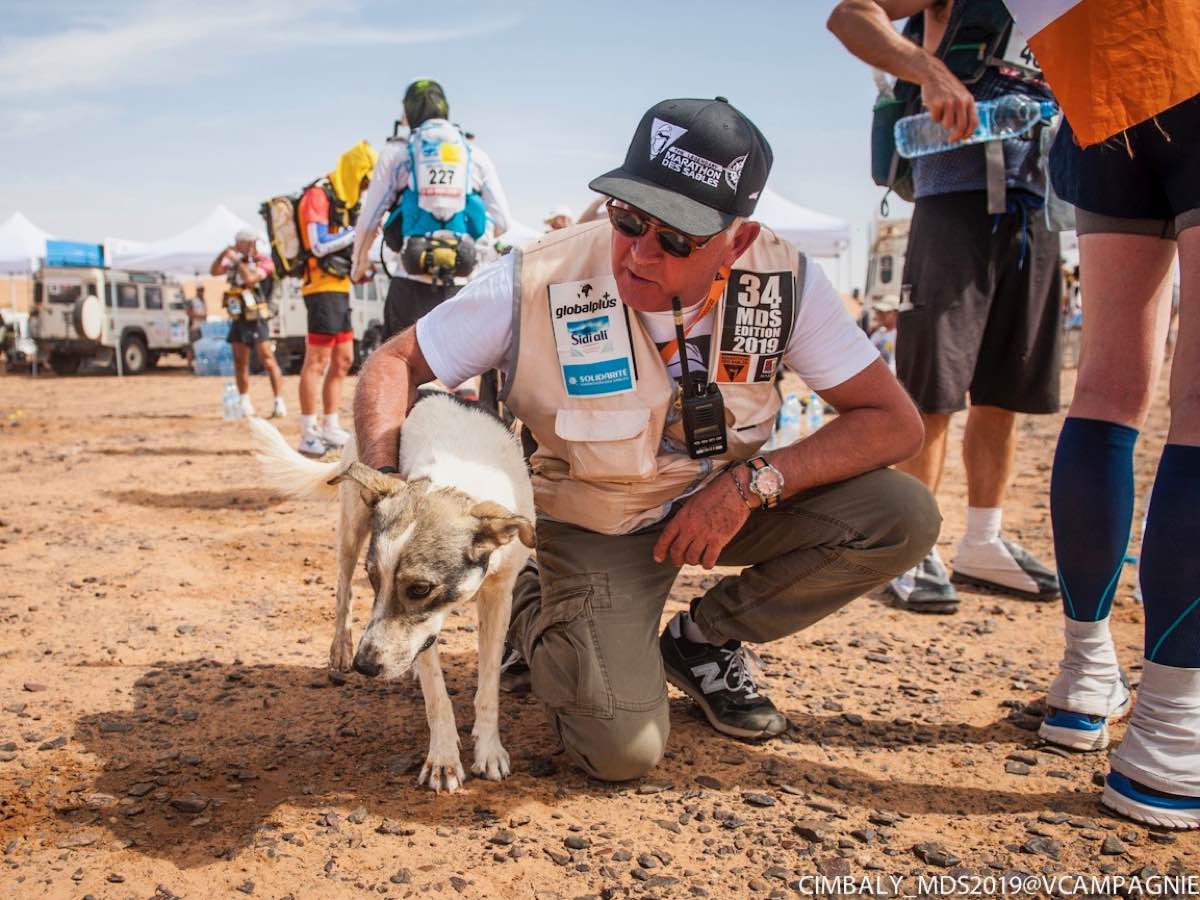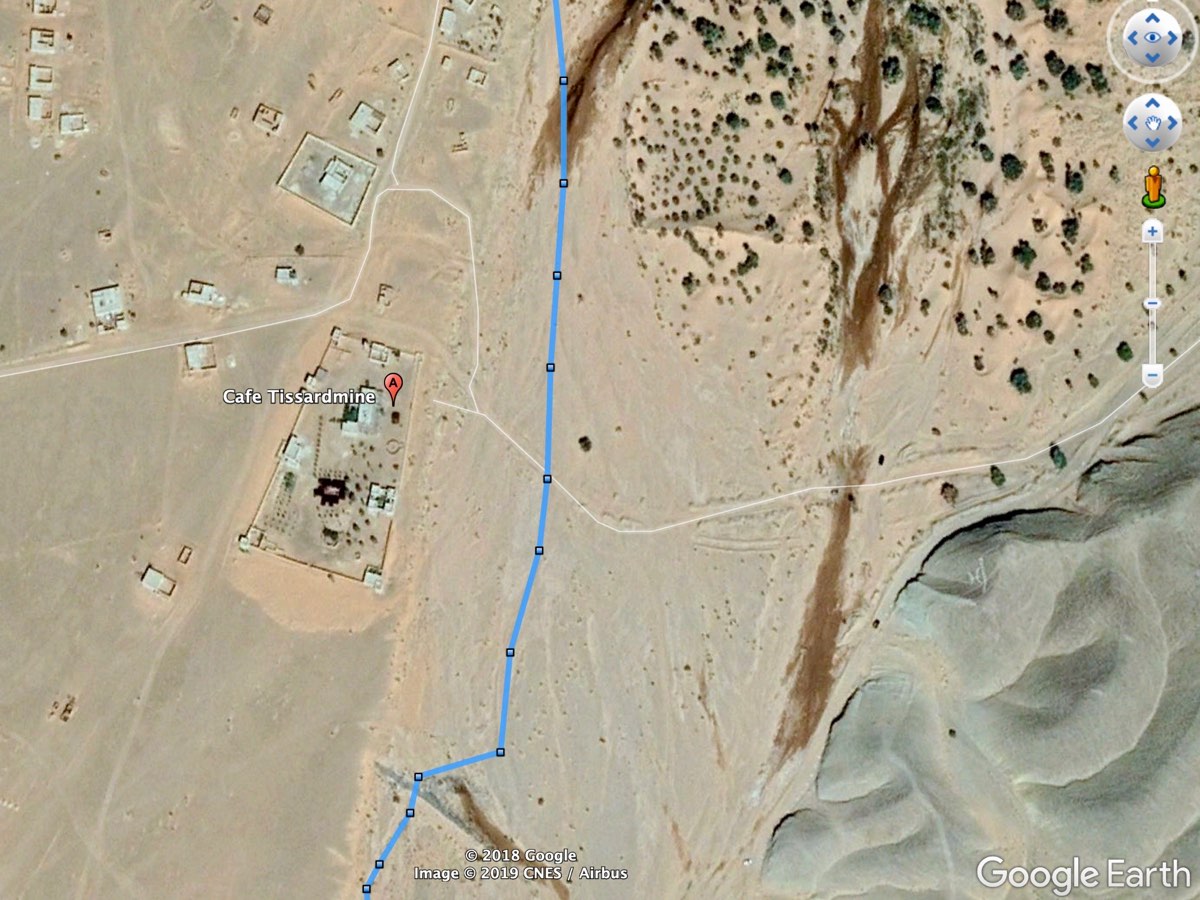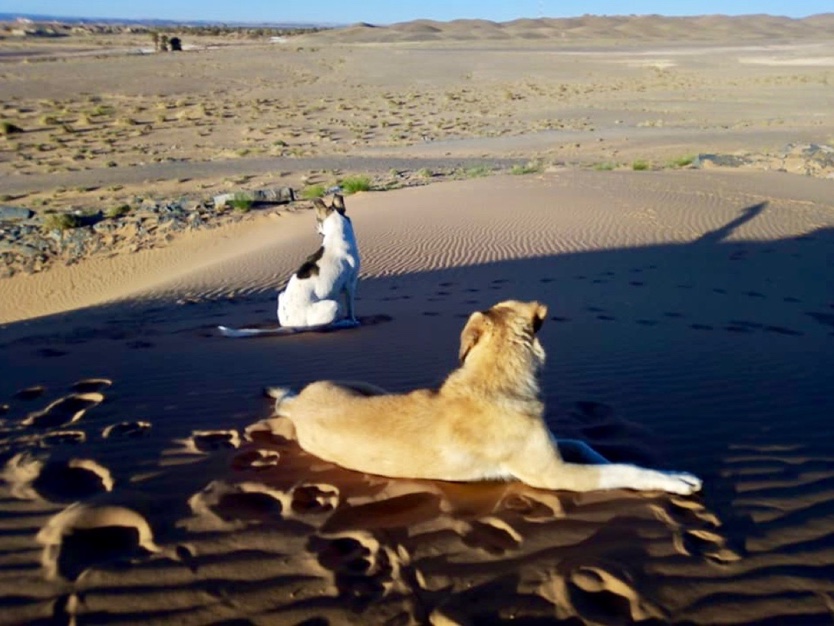[Editor’s Note: iRunFar Managing Editor Meghan Hicks met Diggedy the Sahara Desert dog while running the 2019 Marathon Des Sables. Here is a little bit of Diggedy’s story.]
I am running through the Erg Chebbi, a massive sea of sand dunes in southern Morocco. As far as the eye can see in every direction, it’s wave upon wave of yellow sand rising to a blue sky. Unexpected motion at the far edge of my peripheral vision–not where other runners should be in front of and behind me–catches my attention. I pivot quickly and there he is, a dog in the dunes. And this is the middle of the Sahara Desert, around noon on a warm spring day. As the crow flies, relative civilization–tiny villages and tourist encampments–is only a handful of miles in every direction. But we’re literally in the middle of the Erg Chebbi, and we’re not birds that can float over it all.
With the ease of a creature comfortable in his skin and the scene, the dog trots on, tracing the dune tops and edges where the sand is compacted the most, shortening his footsteps on the loose bits so as to not sink in, and opening his stride into the canine version of a gallop when the sand tilts downhill. After a few minutes, I can’t see him anymore, him having dropped behind a couple dunes in front of me. Shortly, I arrive at Checkpoint 2. This is Stage 2 of the 2019 Marathon Des Sables, and this checkpoint marks our exit from the massive dunes.

Diggedy and other runners in the Erg Chebbi on the second day of the 2019 Marathon Des Sables. Photo: Cimbaly_MDS2019/Josuef Photo
We carry our own kits of food and camping gear, but the race gives us water rations at these checkpoints set up every four to 10 miles. Here at Checkpoint 2, I take about a quart of water, which I will drink while running the five or so miles from here to today’s finish line.
As I fill my bottles, I spot the dog standing at the outer edge of the checkpoint, being shooed by the race volunteers. I suppose they think he’s a local stray trying to bum a little food and water. The dog doesn’t seem to care, though, his mouth wide open and his tongue falling out the side. People who are familiar with dogs know this expression as the sated smile of a creature who’s had a good bout of exercise.
I leave the checkpoint, following the route markers across a sandy, dry wash and then up a steep embankment to gain the main body of a broad, stony plateau. Soon, I am joined by the dog. This time, instead of trotting on, he stays close, off to my side and a few strides ahead. But unlike me, who is seeking out the shortest and most efficient line while following the route markers across this trail-less, track-less land, the dog zigs this way, then that, and then this way again. Apparently, there’s a lot to see and smell when you’re a dog.
A couple miles later, a herd of donkeys stands off to the right of our route. When the dog realizes they’re out there, he goes still for a minute to watch, and then takes off in their direction. I figure that this is the last time I will see him, that he’s a local dog headed off to do whatever local dogs do.
The miles tick by and I almost forget about the little nomad, but when I cross the finish line and turn around to take it all in, the dog is there, too. Marathon Des Sables is a weeklong, six-stage race, and so today’s finish line is also a campsite at which all of us runners sleep as well as the start line of tomorrow’s stage. This is a campsite for over 1,000 people, with vehicles and tents stretched across the landscape for more than a half mile. We are something of a scene, and I wonder what the dog that is used to the quiet of the desert thinks of it all.
That afternoon and evening, stories about him circulate around camp. “I saw him where we entered the dunes.” “He’s over at the volunteers’ food tent now.” “He ran with me for a little while.”
When we wake the next morning, the dog remains with us. He makes his way around the bivouac and, surprisingly, doesn’t really beg for food or water. Many people offer him both, and he only modestly takes little sips of water from a few. He seems most interested in the attention, specifically belly rubs. When he passes through our area of the bivouac, we all take turns giving him pets. He is a very good boy.
Stage 3 starts, and finishes. The dog runs the whole stage. We confirm in this time that he’s not interested in speed. He runs a bit with one runner, then peels off into a little shade or for a sniff, and then rejoins the race to run with someone else. He lollygags at the water checkpoints, even lying for a nap sometimes.
I don’t see him during Stage 3, but I do see him roving camp afterward. We traveled 23 miles today, but he looks at ease. By now, the race organization has taken interest in the critter, and they’ve welcomed him into our tribe. He is fed and watered, and the medical staff monitors his condition. And he wears the same kind of SPOT tracker that we do.
The race organization has also given him a name: Cactus. I realize, I’m a science nerd but this name is funny. Cacti are plants that, with a singular known exception, are native to the New World. There are no cactuses endemic to the Sahara Desert. Of course, there are numerous other plants adapted to life in this extreme aridity and heat that resemble cacti in lifeways and looks. It is, perhaps, these lookalikes that inspired the dog’s race name.
The race organization has also posted his photo on their website and social media. We runners can’t know this until the race is over because we’re pretty much disconnected, but the dog is becoming an internet sensation. We will later learn that people online are more interested in the dog than the race winners.
His owner has also contacted the race via social media, after seeing his mug all over the internet, identifying the dog as hers. Race director Patrick Bauer tells us during one of his morning briefings that the roving canine has an owner and they will pick him up after the race. This is a relief to many of us who have been worried about what will happen to the dog once the race is over.

Diggedy and Marathon Des Sables race director Patrick Bauer at one of the race checkpoints. Photo: Cimbaly_MDS2019/V. Campagnie
I won’t discover the rest of the story until sleuthing around afterward, but I eventually learn that the dog’s owner is Karen Hadfield, a British ex-patriot who owns an inn called Cafe Tissardmine, located in a village of the same name. In the early kilometers of Stage 2, according to the road book we all received from the race organization which outlined our week’s route, we ran at the edge of this village. After the race, I import the GPX track of one of the racers into Google Earth and see that we actually passed to the immediate east of the inn.

A screenshot from Google Earth showing Cafe Tissardmine and the Marathon Des Sables’s Stage 2 route in blue.
It seems the good boy’s adventure started when some 800 people ran past his house. Now, it’s 1.5 days later and we’re 40-odd miles away. Says his owner after the race, he was already a dog with an aptitude for adventure. It was common for him to disappear from the inn for hours at a time on exploratory romps. About three quarters of a year before the 2019 Marathon Des Sables, as Karen explained it online, the dog turned up and adopted she and the inn as his home.
And one more thing that I won’t learn until after the race, the dog already has a name, given to him by his owner. He is Maurico Odio Truque Diggedy, aka Diggedy.

Diggedy and another dog from the village of Tissardmine on one of his regular walks before he joined the Marathon Des Sables. Photo: Cafe Tissardmine/Karen Hadfield
I suppose the daily plans of a dog are pretty different from that of a human, but Diggedy couldn’t have known what we was getting himself into when he joined the people streaming past his house. He wouldn’t have known that it was the second day of a weeklong race. He couldn’t have known how far we were traveling, or when he’d have access to food and water, or where he’d sleep that night. An adventure was presented and, very simply, he set out.
It is now time for the infamous Stage 4, loved and feared for its length. This year’s Stage 4 is 47 miles. Diggedy trots off the start line with all the runners. Surely, this dog hasn’t run 47 miles continuously before, and, surely, he has no idea that this is what’s ahead. No matter, he’s off. About a half day later, Diggedy crosses the finish line, having reportedly taken the day as casually as he ran the other two, running and resting as he wished.
Competitors are given a little less than a day and a half to complete Stage 4. Those who finish fast like Diggedy get a whole rest day before Stage 5. At the bivouac on the rest day, Diggedy takes occasional strolls through the sand dunes around camp and long naps in the shade. He collects belly rubs from runners, and he’s reportedly fed and watered well by the race organization. Near sunset, while I am out on my own recovery walk, I see him strolling in the sand. While most of us runners hobble around whilst tired, stiff, and blistered, Diggedy has pep in his step and a doggy smile on his face. Very clearly, this creature was meant to roam.
Stage 5, a marathon’s distance, comes and goes, and so does Diggedy. Then, there’s Stage 6, a short charity walk to the Marathon Des Sables’s ultimate finish line. Of course, Diggedy is there again. All told, and not counting any of the distance where he strayed off course to visit with donkeys or sit in the shade or do whatever else it is that Diggedy does, he’s traveled about 120 miles in six days.
Karen, his owner, awaits at the finish line to pick up her adventure boy. By car, he travels those 120-odd miles back to his home, back to the village of Tissardmine, back to morning and evening walks with Karen and her other dog Lucluc, back to roaming the village, and back to napping in the shade. Karen explains all this on her inn’s Facebook page, emphasizing all the sleeping Diggedy does in the days after the race.
Diggedy’s big adventure must have inspired, I don’t know, millions of people. There were about 1,000 of us out in the desert and his adventure went viral on the internet. I mean, for Pete’s sake, the New York Times published an article about Diggedy. But the question is, why? What exactly is so enlivening about a dog joining–and finishing–a weeklong running race?
Could it be at least in part his spontaneity, how he just forged out on an unknown path, that inspires us? The Marathon Des Sables is marketed as among the harder running races out there. It’s a bucket-list item that many of us spend ages preparing mentally and physically for. But on a random Monday morning in early April, with no training, no preparation, and no warning, a dog called Diggedy joined a caravan of 800 runners, their and therefore his destination unknown.
We live in an age where regiment has become a defining factor of human existence, where our days are scheduled from before sun up to after sun down and where we plan to run a race in the Sahara Desert a year in advance. It also seems that, despite this, a desire for freedom remains part of our humanity, too. And so, the floppy-eared, free-spirited Diggedy and his 120 miles of running remind us all of the joy in having room to roam.

Diggedy resting with his Marathon Des Sables finisher’s medal after completing Stage 5, a marathon’s distance and the event’s final competitive stage. Photo: Cimbaly_MDS2019

Diggedy back at home at Cafe Tissardmine where he spent a number of days resting after the Marathon Des Sables. Photo: Cafe Tissardmine/Karen Hadfield



